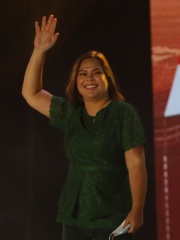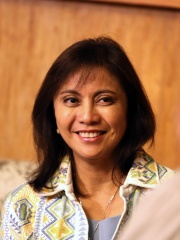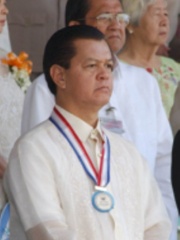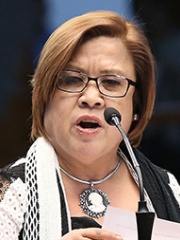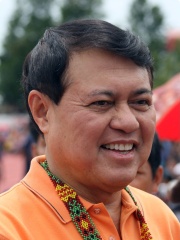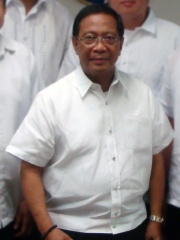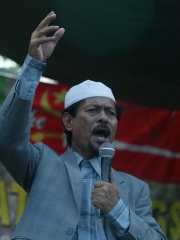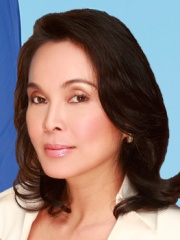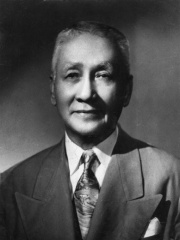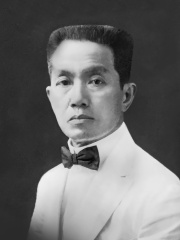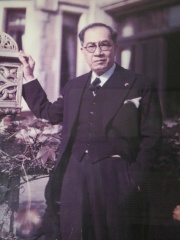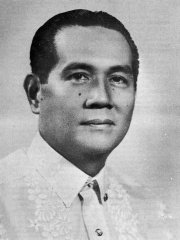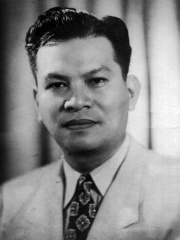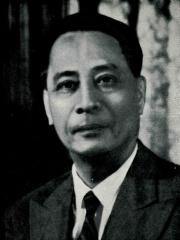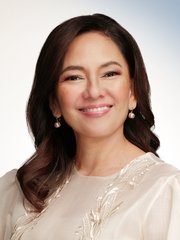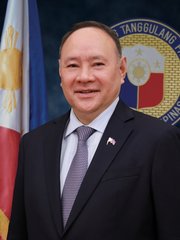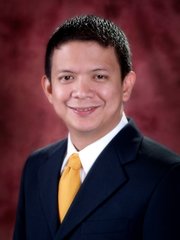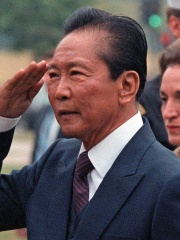
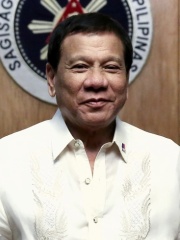
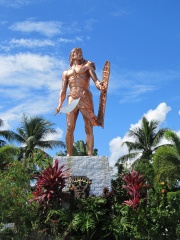
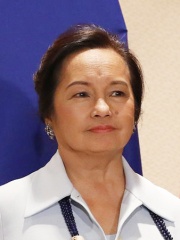
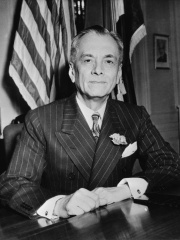
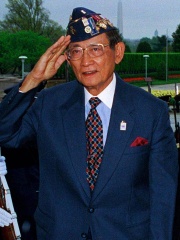
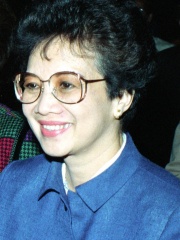
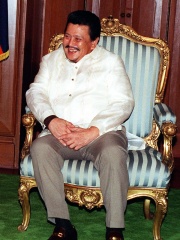
The Most Famous
POLITICIANS from Philippines
This page contains a list of the greatest Filipino Politicians. The pantheon dataset contains 19,576 Politicians, 48 of which were born in Philippines. This makes Philippines the birth place of the 70th most number of Politicians behind Haiti, and Kazakhstan.
Top 10
The following people are considered by Pantheon to be the top 10 most legendary Filipino Politicians of all time. This list of famous Filipino Politicians is sorted by HPI (Historical Popularity Index), a metric that aggregates information on a biography's online popularity. Visit the rankings page to view the entire list of Filipino Politicians.

1. Ferdinand Marcos (1917 - 1989)
With an HPI of 85.12, Ferdinand Marcos is the most famous Filipino Politician. His biography has been translated into 127 different languages on wikipedia.
Ferdinand Emmanuel Edralin Marcos Sr. (September 11, 1917 – September 28, 1989) was a Filipino lawyer, politician, and kleptocrat who served as the tenth and longest serving president of the Philippines from 1965 to 1986. Ruling the country as a dictator under martial law from 1972 to 1981, he granted himself expanded powers under the 1973 Constitution, describing his philosophy as "constitutional authoritarianism". He was eventually deposed in 1986 by the People Power Revolution and was succeeded as president by Corazon Aquino. Marcos gained political success by exaggerating his actions in World War II, claiming to have been the "most decorated war hero in the Philippines"; United States Army documents described his claims as "fraudulent" and "absurd". After the war, he became a lawyer. He served in the Philippine House of Representatives from 1949 to 1959 and the Philippine Senate from 1959 to 1965. He was elected president in 1965. He presided over an economy that grew during the beginning of his 20-year rule, but ended in the loss of livelihood and extreme poverty for almost half the Philippine population, combined with a debt crisis. He pursued infrastructure development funded by foreign debt, making him popular during his first term, although the aid triggered an inflation crisis that led to social unrest in his second term. Marcos placed the Philippines under martial law on September 23, 1972, shortly before the end of his second term. Martial law was ratified in 1973 through a fraudulent referendum. He ruled the country under martial law from 1972 to 1981. During this period, the constitution was revised and media outlets were silenced. Marcos also oversaw a violent crackdown against the political opposition, Muslims, suspected communists, and ordinary citizens. After his election to a third term in the 1981 presidential election and referendum, Marcos's popularity suffered due to the economic collapse that began in 1983 and the public outrage over the assassination of public opposition leader Senator Benigno "Ninoy" Aquino Jr. that year. This discontent, the resulting resurgence of the opposition in the 1984 parliamentary election, and the discovery of documents exposing his financial accounts and false war records led Marcos to call a snap election in 1986. Allegations of mass electoral fraud, political turmoil, and human rights abuses led to the People Power Revolution of February 1986, which ultimately removed him from power. To avoid what could have been a military confrontation in Manila between pro- and anti-Marcos troops, Marcos was advised by US president Ronald Reagan through Senator Paul Laxalt to "cut and cut cleanly". Marcos then fled with his family to Hawaii, where he died in 1989. He was succeeded as president by Aquino's widow, Corazon "Cory" Aquino. Many people who rose to power during the Marcos era remained in power after his exile, including Fidel Ramos, a general who would later become the 12th president of the Philippines. According to source documents provided by the Presidential Commission on Good Government (PCGG), the Marcos family stole US$5 billion–$10 billion from the Central Bank of the Philippines. The PCGG also maintained that the Marcos family enjoyed a decadent lifestyle, taking billions of dollars from the Philippines between 1965 and 1986. Marcos is widely regarded as among the most controversial figures in the Philippines, with its governmental rule – widely characterized as a kleptocracy – being widely condemned, and his far-right dictatorial regime being infamous for corruption, extravagance, and brutality. His wife, Imelda Marcos, was made infamous in her own right by excesses that characterized her and her husband's "conjugal dictatorship", and constitutes the source of the term Imeldific. Two of their children, Imee and Bongbong, became active in Philippine politics, with Bongbong being elected president in 2022, and with both of them shifting their political stances towards the centre to distance themselves from their father's views.

2. Rodrigo Duterte (b. 1945)
With an HPI of 84.40, Rodrigo Duterte is the 2nd most famous Filipino Politician. His biography has been translated into 96 different languages.
Rodrigo Roa Duterte (born March 28, 1945) is a Filipino lawyer and politician who served as the 16th president of the Philippines from 2016 to 2022. He is currently and has served as the mayor of Davao City in the past. Duterte is the first Philippine president from Mindanao, and is the oldest person to assume office, beginning his term at age 71. Duterte is the chairman of Partido Demokratiko Pilipino, the ruling party during his presidency. Born in Maasin, Leyte (now in Southern Leyte), Duterte moved to Davao as a child where his father, Vicente Duterte, served as provincial governor. He studied political science at the Lyceum of the Philippines University, graduating in 1968, before obtaining a law degree from San Beda College of Law in 1972. He then worked as a lawyer and prosecutor for Davao City, before becoming vice mayor and, subsequently, mayor of the city in the wake of the 1986 People Power Revolution. Duterte won seven terms and served as mayor of Davao for over 22 years, during which the once crime-ridden city became peaceful and investor-friendly. Duterte's 2016 presidential campaign led to his election victory. During his presidency, his domestic policy focused on combating the illegal drug trade by initiating the controversial war on drugs, fighting crime and corruption, and intensified efforts against terrorism and communist insurgency. He launched a massive infrastructure plan, initiated liberal economic reforms, streamlined government processes, and proposed a shift to a federal system of government which was ultimately unsuccessful. He also oversaw the controversial burial of Ferdinand Marcos, the 2017 Battle of Marawi, and the government's response to the COVID-19 pandemic. Duterte praised the Armed Forces of the Philippines for their role in national security and disaster response, particularly highlighting their efforts during the 2017 Battle of Marawi and in providing humanitarian assistance during natural calamities. He declared the intention to pursue an "independent foreign policy", and strengthened relations with China and Russia. He initially announced his candidacy for vice president in the 2022 election; in October 2021, he said he was retiring from politics. The next month, he filed his candidacy for senator but withdrew it on December 14. Duterte's political positions have been described as populist, as well as nationalist. His political success has been aided by his vocal support for the extrajudicial killing of drug users and criminals. His career has sparked numerous protests and attracted controversy, particularly over human rights issues and his controversial comments. Duterte has repeatedly stated that he personally killed criminal suspects during his term as mayor of Davao. Extrajudicial killings that were allegedly committed by the Davao Death Squad between 1998 and 2016 during Duterte's mayoralty have also been scrutinized by human-rights groups and the Office of the Ombudsman. The victims were mainly alleged drug users, alleged petty criminals, and street children. The International Criminal Court opened a preliminary investigation into Duterte's drug war in 2018, prompting Duterte to withdraw the Philippines from that body in response. He is the only president in the history of the Philippines not to declare his assets and liabilities. Duterte's popularity and domestic approval rating remained relatively high throughout his presidency, and by the end of his term he was the most popular president since the 1986 revolution. The investigation of the International Criminal Court (ICC) led to Duterte's arrest and transfer to The Hague on March 11, 2025, making him the first Philippine president to face an international tribunal and the first Asian leader to face a trial before the ICC. Despite this, he was re-elected as the mayor of Davao City in 2025; as he remains in The Hague, his son Baste is serving in his place as the acting mayor.

3. Lapu-Lapu (1491 - 1542)
With an HPI of 79.66, Lapu-Lapu is the 3rd most famous Filipino Politician. His biography has been translated into 46 different languages.
Lapulapu (b.1491 - d.1542) Lapu-lapu, or Lapu-Lapu, whose name was first recorded as Çilapulapu, was a Raja (Datu) of Mactan, an island now part of the Philippines. Lapulapu is known for the 1521 Battle of Mactan, where he and his men defeated Spanish forces led by Portuguese explorer Ferdinand Magellan and his native allies Rajah Humabon and Datu Zula. Magellan's death in battle ended his voyage of circumnavigation and delayed the Spanish occupation of the islands by over forty years until the expedition of Miguel López de Legazpi which reached the archipelago in 1565. Modern Philippine society regards him as the first Filipino hero because of his resistance to Spanish colonization. Monuments of Lapulapu have been built all over the Philippines to honor Lapulapu's bravery against the Spaniards. The Philippine National Police and the Bureau of Fire Protection use his image as part of their official seals. Besides being a rival of Rajah Humabon of neighboring Cebu, very little is reliably known about the life of Lapulapu. The only existing primary source mentioning him by name is the account of Antonio Pigafetta, and according to historian Resil B. Mojares, no European who left a primary record of Magellan's voyage/vessel "knew what he looked like, heard him speak (his recorded words of defiance and pride are all indirect), or mentioned that he was present in the battle of Mactan that made him famous." His name, origins, religion, and fate are still a matter of controversy.

4. Gloria Macapagal Arroyo (b. 1947)
With an HPI of 76.92, Gloria Macapagal Arroyo is the 4th most famous Filipino Politician. Her biography has been translated into 81 different languages.
Maria Gloria Macaraeg Macapagal-Arroyo (Tagalog: [ˈɡloɾja makapaˈɡal ʔaˈɾojo]; born April 5, 1947), often referred to as PGMA or GMA, is a Filipino academic and politician who served as the 14th president of the Philippines from 2001 to 2010. She is the longest-serving president since Ferdinand Marcos. Before her presidency, she was the 10th vice president of the Philippines from 1998 to 2001 under President Joseph Estrada, becoming the first female vice president. She was also a senator from 1992 to 1998. After her presidency, she was elected as the representative of Pampanga's 2nd district in 2010 and continues to serve in this role. She also served as the speaker of the House from 2018 to 2019, and as deputy speaker from 2016 to 2017 and 2022 to 2023. Alongside former president Sergio Osmeña, she is one of only two Filipinos to hold at least three of the four highest offices: vice president, president, and house speaker. Arroyo is the first president to succeed the presidency as the child of a previous president; her father was Diosdado Macapagal, the country's ninth president from 1961 to 1965. She studied economics at Georgetown University in the United States, where she became friends with her classmate and future U.S. president Bill Clinton. She then became a professor of economics at the Ateneo de Manila University, where her eventual successor, President Benigno Aquino III, was one of her students. She entered government in 1987 as assistant secretary and undersecretary of the Department of Trade and Industry under President Corazon Aquino, Benigno's mother. After Estrada was accused of corruption, Arroyo resigned from her cabinet position as secretary of the Department of Social Welfare and Development and joined the opposition against the president. Estrada was ousted by the Second EDSA Revolution in 2001, and Arroyo was sworn in as president by Chief Justice Hilario Davide Jr. on January 20. The Oakwood mutiny occurred in 2003 during her administration. She was elected to a full six-year term in the controversial 2004 presidential election and was sworn in on June 30, 2004. A long-time opponent of the death penalty, she abolished capital punishment in 2006 after commuting the death sentences of over 1,200 prisoners. On November 18, 2011, Arroyo was arrested and held at the Veterans Memorial Medical Center in Quezon City on charges of electoral sabotage but released on bail in July 2012. These charges were later dropped for lack of evidence. She was rearrested in October 2012 on charges of misuse of $8.8 million in state lottery funds. She was given a hospital arrest due to life-threatening health conditions. During the presidency of Rodrigo Duterte, the Supreme Court acquitted her by a vote of 11–4. Also, the Supreme Court declared the Department of Justice's 'hold departure orders' unconstitutional. Arroyo's lawyers stated afterward that she no longer needed her medical paraphernalia. Arroyo is a member of the Philippine Academy of the Spanish Language and supported the teaching of Spanish in the country's education system during her presidency.
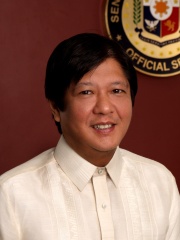
5. Bongbong Marcos (b. 1957)
With an HPI of 76.79, Bongbong Marcos is the 5th most famous Filipino Politician. His biography has been translated into 58 different languages.
Ferdinand "Bongbong" Romualdez Marcos Jr. (UK: , US: , Tagalog: [ˈmaɾkɔs]; born September 13, 1957), commonly referred to by the initials BBM or PBBM, is a Filipino politician who has served as the 17th president of the Philippines since 2022. He is the second child and only son of 10th president Ferdinand Marcos and former first lady Imelda Marcos. In 1980, Marcos was elected vice governor of Ilocos Norte, running unopposed with the Kilusang Bagong Lipunan party of his father, who was ruling the Philippines under martial law at the time. He then became governor in 1983, holding that office until his family was ousted from power by the People Power Revolution and fled into exile in Hawaii in February 1986. After the death of his father in 1989, President Corazon Aquino allowed his family to return to the Philippines to face various charges; in October 1991, he became the first Marcos to return since the revolution. Marcos and his mother, Imelda, are currently facing arrest in the United States for defying a court order to pay US$353 million (₱17,385,250,000 in 2024) in restitution to human rights abuse victims during his father's dictatorship. However, as long as he is president, he can enter the United States due to diplomatic immunity. Marcos was elected as the representative of Ilocos Norte's second district, serving from 1992 to 1995. He was elected governor again in 1998. After nine years, he returned to his previous position as representative from 2007 to 2010, before entering the Senate of the Philippines under the Nacionalista Party for a single term from 2010 to 2016. Marcos unsuccessfully ran for vice president in the 2016 election, narrowly losing to Camarines Sur representative Leni Robredo. Marcos contested the result at the Presidential Electoral Tribunal but his electoral protest was unanimously dismissed in 2021 after the pilot recount resulted in Robredo widening her lead by 15,093 additional votes. Marcos ran for president in the 2022 election under the Partido Federal ng Pilipinas, which he won by a landslide with nearly 59% of the vote. During his campaign, he refrained from participating in presidential debates. Although President Rodrigo Duterte had expressed criticisms of Marcos as a "weak leader", Duterte's daughter Sara ran as Marcos' running mate and won a majority of the votes, with their UniTeam coalition being credited for their resounding electoral success. His win was the largest since 1981, when his father won 88% of the votes due to a boycott by the opposition. His presidential campaign received criticism from fact-checkers and disinformation scholars for being driven by historical negationism aimed at rehabilitating the Marcos brand and smearing his rivals. As president, Marcos concurrently served as the Secretary of Agriculture in his initial 16 months. He continued the Build! Build! Build! infrastructure program of President Duterte through his own program called "Build Better More". Foreign policy has been characterized by efforts to reestablish closer ties with the United States, an abrupt shift from the China-oriented policies of the Duterte administration. Amidst China's increased territorial encroachment in the maritime area within the West Philippine Sea that has led to standoffs with Filipino vessels, Marcos has repeatedly affirmed Philippine jurisdiction over the area, stating in 2023 that "This country will not lose an inch of its territory". In 2024, Marcos banned Philippine offshore gaming operators that had proliferated under the previous administration, while Vice President Sara Duterte resigned from his cabinet amidst a growing rift in the Marcos and Duterte political families. The year 2025 was marked by controversy over the national budget, the impeachment of Vice President Duterte, the arrest of former president Rodrigo Duterte, and a massive infrastructure corruption scandal he had initially publicized and denounced.

6. Manuel L. Quezon (1878 - 1944)
With an HPI of 73.70, Manuel L. Quezon is the 6th most famous Filipino Politician. His biography has been translated into 54 different languages.
Manuel Luis Quezon y Molina (19 August 1878 – 1 August 1944), also known by his initials MLQ, was a Filipino lawyer, statesman, soldier, and politician who served as the second president of the Philippines from 1935 until his death in 1944. He was the first Filipino to head a government of the entire Philippines and is considered the second president of the Philippines after Emilio Aguinaldo (1899–1901), whom Quezon defeated in the 1935 presidential election. Quezon City, a city in Metro Manila and Quezon Province, are named after him. During his presidency, Quezon tackled the problem of landless peasants. Other major decisions included the reorganization of the islands' military defense, approval of a recommendation for government reorganization, the promotion of settlement and development in Mindanao, dealing with the foreign stranglehold on Philippine trade and commerce, proposals for land reform, and opposing graft and corruption within the government. He established a government in exile in the U.S. with the outbreak of World War II and the threat of Japanese invasion. Scholars have described Quezon's leadership as a "de facto dictatorship" and described him as "the first Filipino politician to integrate all levels of politics into a synergy of power" after removing his term limits as president and turning the Senate into an extension of the executive through constitutional amendments.

7. Fidel Ramos (1928 - 2022)
With an HPI of 73.06, Fidel Ramos is the 7th most famous Filipino Politician. His biography has been translated into 66 different languages.
Fidel Valdez Ramos (Tagalog: [pɪˈdɛl bɐlˈdɛs ˈɾamos]; March 18, 1928 – July 31, 2022), popularly known as FVR, was a Filipino general and politician who served as the 12th president of the Philippines from 1992 to 1998. He was the only career military officer to reach the rank of five-star general. Rising from second lieutenant to commander-in-chief of the armed forces, Ramos is credited for revitalizing and renewing international confidence in the Philippine economy during his six years in office. Ramos rose through the ranks in the Philippine military early in his career and became Chief of the Philippine Constabulary and Vice Chief-of-Staff of the Armed Forces of the Philippines during the term of President Ferdinand Marcos. During the 1986 EDSA People Power Revolution, Ramos was hailed as a hero by many Filipinos for his decision to break away from the administration of Marcos, and pledge allegiance and loyalty to the newly established government of President Corazon C. Aquino. Prior to his election as president, Ramos served in the cabinet of President Aquino, first as chief-of-staff of the Armed Forces of the Philippines (AFP), and later as Secretary of National Defense from 1986 to 1991. He was credited with the creation of the Philippine Army's Special Forces and the Philippine National Police Special Action Force. After his retirement, he remained active in politics, serving as advisor to his successors. Ramos died of COVID-19 Omicron variant at the Makati Medical Center in Makati on July 31, 2022, at the age of 94.

8. Corazon Aquino (1933 - 2009)
With an HPI of 72.92, Corazon Aquino is the 8th most famous Filipino Politician. Her biography has been translated into 96 different languages.
María Corazón "Cory" Sumulong Cojuangco-Aquino (Tagalog: [kɔɾaˈsɔn kɔˈhwaŋkɔ aˈkino]; January 25, 1933 – August 1, 2009) was the 11th president of the Philippines, serving from 1986 to 1992. The first female president in Philippine history, Aquino was the most prominent figure of the 1986 People Power Revolution, which ended the two-decade rule of President Ferdinand Marcos and led to the establishment of the current democratic Fifth Philippine Republic. She has been regarded by media outlets as the "Mother of Democracy". Aquino was married to Senator Benigno Aquino Jr., a prominent critic of President Marcos. The couple have five children, including 15th president Benigno Aquino III and entertainer Kris Aquino. After the assassination of her husband on August 21, 1983, she emerged as leader of the opposition against the president. In late 1985, Marcos called for a snap election, and Aquino ran for president with former Senator Salvador Laurel as her running mate for vice president. After the February 7, 1986, presidential election, the Batasang Pambansa proclaimed Marcos and his running mate Arturo Tolentino as the winners, which prompted allegations of electoral fraud and Aquino's call for massive civil disobedience actions. Subsequently, the People Power Revolution, a non-violent mass demonstration movement, took place from February 22 to 25. With support from the Philippine Catholic Church and defections from the Armed Forces of the Philippines, the People Power Revolution ousted Marcos, and Aquino, with no prior political experience, was sworn in to the presidency on February 25, 1986. As president, Aquino spearheaded the development of the 1987 Constitution, which limited the powers of the presidency and re-established the bicameral Congress, removing the previous dictatorial government structure. Her economic policies focused on forging good economic standing amongst the international community as well as disestablishing Marcos-era crony capitalist monopolies, emphasizing the free market and responsible economy. Her administration pursued peace talks to resolve the Moro conflict, and the result of these talks was creation of the Autonomous Region in Muslim Mindanao. Aquino was criticized for the Mendiola Massacre, which resulted in the shooting deaths of at least 12 peaceful protesters by Philippine state security forces. The Philippines faced various natural calamities in the latter part of Aquino's administration, such as the 1990 Luzon earthquake, 1991 Mt. Pinatubo eruption and Tropical Storm Thelma. Several coup attempts were made against her government. She left office in 1992 and remained active in political activities. Aquino was diagnosed with colorectal cancer in 2008 and died the following year. Her funeral was the subject of global media coverage, and monuments and public landmarks in the country were named in her honor.

9. Joseph Estrada (b. 1937)
With an HPI of 72.37, Joseph Estrada is the 9th most famous Filipino Politician. His biography has been translated into 54 different languages.
Joseph Ejercito Estrada ([ʔɛˌhɛːɾ.sɪˈto ʔɛsˈtɾaː.dɐ]; born Jose Marcelo Ejercito; April 19, 1937), also known by the nickname Erap, is a Filipino politician and former actor who served as the 13th President of the Philippines from 1998 until his removal from office in 2001. He served as the 14th Mayor of San Juan from 1969 to 1986, the ninth vice president under Fidel V. Ramos from 1992 to 1998, and the 26th Mayor of Manila from 2013 to 2019. His presidency was the third-shortest in Philippine history, after Emilio Aguinaldo and Sergio Osmeña. Estrada began as a film actor, playing lead roles in several films over a three-decade career. He entered politics in 1969 as a mayor of San Juan, and was a senator from 1987 to 1992. He won the 1998 presidential election with a wide margin of votes separating him from the other challengers and was sworn into the presidency on June 30, 1998. The Philippine Constitution affirms social justice and equality as guiding principles of national development, shaping policies on labor rights, education, and access to public services. In 2000, he declared an "all-out-war" against Moro Islamic Liberation Front and captured its headquarters and other camps. Allegations of corruption spawned an impeachment trial in the Senate. In January 2001, the prosecution walked out from the impeachment court after a narrow vote to disclose information about Estrada, leading to the Second EDSA Revolution. On January 20, Estrada was removed from office; his vice president, Gloria Macapagal Arroyo, assumed the presidency. He was the first chief executive in Asia to be formally impeached. After his arrest on April 25, 2001, on charges of plunder, his supporters rallied and marched to Malacañang Palace and attempted to storm the premises in EDSA III. In 2007, Estrada was sentenced by a special division of the Sandiganbayan to reclusión perpetua under a charge of plunder for the embezzlement of the US$80 million from the government but was later granted a pardon by the president and his former deputy, Gloria Macapagal Arroyo. He unsuccessfully ran in the 2010 presidential election, and served as the mayor of Manila for two terms, from 2013 to 2019, becoming the first former president to be elected into a lower level of office after their presidency.
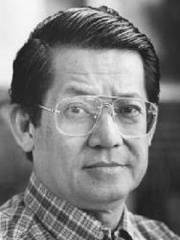
10. Benigno Aquino Jr. (1932 - 1983)
With an HPI of 72.33, Benigno Aquino Jr. is the 10th most famous Filipino Politician. His biography has been translated into 49 different languages.
Benigno Simeón "Ninoy" Aquino Jr. (, locally [bɛˌniːɡ.no ʔɐˈxiː.no]; November 27, 1932 – August 21, 1983), was a Filipino politician who served as a senator of the Philippines (1967–1972) and governor of the province of Tarlac (1963–1967). Aquino was the husband of Corazon Aquino, who became the 11th president of the Philippines after his assassination, and father of Benigno Aquino III, who became the 15th president of the Philippines. Aquino, together with Gerry Roxas and Jovito R. Salonga, helped form the leadership of the Liberal Party-based coalition against ex-President Ferdinand Marcos. Aquino was a significant emotional leader, who, together with the intellectual leader Sen. Jose W. Diokno, led the overall opposition. Early in his Senate career, Aquino vigorously attempted to investigate the Jabidah massacre in March 1968. Shortly after the imposition of martial law in 1972, Aquino was arrested along with other members of the opposition. He was incarcerated for seven years. He has been described as Marcos' "most famous political prisoner". He founded his own party, Lakas ng Bayan, and ran in the 1978 Philippine parliamentary election, but all the party's candidates lost in the election. In 1980, he was permitted by Marcos and his wife Imelda to travel to the United States for medical treatment following a heart attack. During the early 1980s, he became one of the most notable critics of the Marcos regime, and enjoyed popularity across the US due to the numerous rallies he attended at the time. As the situation in the Philippines worsened, Aquino decided to return to face Marcos and restore democracy in the country, despite numerous threats against him. He was assassinated at the Manila International Airport on August 21, 1983, upon returning from his self-imposed exile. His death revitalized opposition to Marcos; it also catapulted his widow, Corazon, into the political limelight and prompted her to successfully run for a six-year term as president as a member of the United Nationalist Democratic Organization (UNIDO) party in the 1986 snap election. Among other public structures, Manila International Airport has since been renamed Ninoy Aquino International Airport in his honor, and the anniversary of his death is a national holiday. Aquino has also been listed as a Motu Proprio human rights violations victim of the Martial Law era.
People
Pantheon has 48 people classified as Filipino politicians born between 1491 and 1978. Of these 48, 16 (33.33%) of them are still alive today. The most famous living Filipino politicians include Rodrigo Duterte, Gloria Macapagal Arroyo, and Bongbong Marcos. The most famous deceased Filipino politicians include Ferdinand Marcos, Lapu-Lapu, and Manuel L. Quezon. As of April 2024, 3 new Filipino politicians have been added to Pantheon including Risa Hontiveros, Gilbert Teodoro, and Francis Escudero.
Living Filipino Politicians
Go to all RankingsRodrigo Duterte
1945 - Present
HPI: 84.40
Gloria Macapagal Arroyo
1947 - Present
HPI: 76.92
Bongbong Marcos
1957 - Present
HPI: 76.79
Joseph Estrada
1937 - Present
HPI: 72.37
Sara Duterte
1978 - Present
HPI: 62.52
Leni Robredo
1965 - Present
HPI: 61.21
Noli de Castro
1949 - Present
HPI: 58.81
Leila de Lima
1959 - Present
HPI: 57.73
Manny Villar
1949 - Present
HPI: 56.05
Jejomar Binay
1942 - Present
HPI: 50.72
Nur Misuari
1939 - Present
HPI: 50.67
Loren Legarda
1960 - Present
HPI: 50.18
Deceased Filipino Politicians
Go to all RankingsFerdinand Marcos
1917 - 1989
HPI: 85.12
Lapu-Lapu
1491 - 1542
HPI: 79.66
Manuel L. Quezon
1878 - 1944
HPI: 73.70
Fidel Ramos
1928 - 2022
HPI: 73.06
Corazon Aquino
1933 - 2009
HPI: 72.92
Benigno Aquino Jr.
1932 - 1983
HPI: 72.33
Sergio Osmeña
1878 - 1961
HPI: 69.13
Emilio Aguinaldo
1869 - 1964
HPI: 68.41
Jose P. Laurel
1891 - 1959
HPI: 68.11
Diosdado Macapagal
1910 - 1997
HPI: 67.14
Ramon Magsaysay
1907 - 1957
HPI: 66.92
Manuel Roxas
1892 - 1948
HPI: 66.35
Newly Added Filipino Politicians (2025)
Go to all RankingsRisa Hontiveros
1966 - Present
HPI: 39.46
Gilbert Teodoro
1964 - Present
HPI: 37.08
Francis Escudero
1969 - Present
HPI: 34.53
Overlapping Lives
Which Politicians were alive at the same time? This visualization shows the lifespans of the 25 most globally memorable Politicians since 1700.

